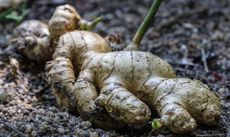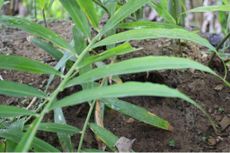Herbs
Whether just starting out, looking for growing info, or need help identifying edible herbs, you’ve come to the right place. There are a number of herbs that can be grown in the garden—some for medicinal reasons, some for aesthetic reasons, and others being common herbs you can eat, cook with or use in teas. Learning how to grow herbs is easy, and with the right know how, identifying edible herbs will become second nature. So whatever the reason, we can help with all your herb growing needs.
Herbs
-

What’s Wrong With My Ginseng – Learn About Ginseng Disease Control
Whether grown in containers at home or planted en masse as a means of income, ginseng is highly prized. It is easy to imagine that growers may become quite alarmed when faced with sick ginseng plants. Learn about common diseases in this article.
By Tonya Barnett
-

Varieties Of Ginseng For The Home Gardener
There are several types of ginseng on the market today, including a few varieties of “ginseng” that are similar in many ways, but aren’t actually a true ginseng. Click on the following article to learn more about different types of ginseng.
By Mary H. Dyer
-

Ginger Harvesting Guide – Learn How To Harvest Ginger Plants
People have been harvesting ginger root for its aromatic, spicy rhizomes for centuries. Given that these delectable roots are underground, how do you know if its ginger harvesting time? Click here to find out when to pick and how to harvest ginger.
By Amy Grant
-

Ginger With Brown Leaves: Learn Why Ginger Leaves Are Turning Brown
Ginger plants are interesting additions to gardens, but they can be fickle about growing conditions. Brown leaves can be an alarming symptom, but the chances are good that your plant is showing a sign of stress, rather than a sign of sickness. Learn more here.
By Kristi Waterworth
-

Kettle River Giant Garlic: Tips For Growing Kettle River Garlic In The Garden
Many garlics are grown specifically for fresh eating, but the strong flavors other varieties make them more suited for use in garlic butters and seasoning of meats and pasta dishes. ‘Kettle River Giant,’ for example, is prized for its attributes in cooking. Learn more here.
By Tonya Barnett
-

German White Garlic Info – How To Grow German White Garlic
According to German White garlic information, this is a large, strong-flavored hardneck type garlic. German White garlic is a Porcelain type with satin white bulbs. For information about how to grow German White garlic, click this article.
By Teo Spengler
-

My Garlic Looks Like An Onion – Why Are My Garlic Cloves Not Forming
Growing your own garlic is pretty easy. Home-grown garlic has so much more flavor than what you’ll find at the store. But if you have no garlic cloves or your garlic isn’t forming bulbs, it’s hard to enjoy the harvest. Troubleshoot the issue here to prevent it from reoccurring.
By Mary Ellen Ellis
-

Scented Geranium Care: How To Grow Scented Geranium
Scented geranium plants are a sensual delight in any home or garden. Read the following article to get tips on growing scented geranium plants so you can take advantage of all they have to offer.
By Jackie Rhoades
-

What Is Genovese Basil: Learn About Genovese Basil Growing And Care
Fresh or dried, basil leaves are an essential ingredient in many Italian, Greek and Asian dishes. If you love to make fresh from the garden pesto or caprese salad, you may be growing a type of sweet basil known as Genovese basil. Click here to learn more.
By Darcy Larum
-

Ginger Mint Herbs: Tips On Growing Ginger Mint In Gardens
You may know ginger mint plants by one of their many alternate names: redmint, Scotch spearmint, or golden apple mint. Whatever you choose to call them, ginger mint is handy to have around. Learn about growing ginger mint in this article.
By Mary H. Dyer
-

Forcing Chicory Plants – Learn About Chicory Root Forcing
Have you ever heard of forcing chicory plants? Chicory root forcing is a common procedure that transforms the roots into something marvelous. If you are growing chicory, and are wondering “should I force chicory,” the resounding answer is yes! Learn more here.
By Amy Grant
-

Boll Weevil History – Learn About The Boll Weevil And Cotton Plants
The story of the boll weevil and cotton is a long one, lasting many decades. To learn more about cotton boll weevil problems, click the following article.
By Laura Miller
-

What Is Fino Verde Basil – Tips For Growing Fino Verde Basil
Fino Verde basil plants are attractive in flower beds or herb gardens, and with a mature height of 6 to 12 inches (15-30 cm.), they are ideal for containers. Growing Fino Verde basil is easy; learn how to grow this basil plant in the following article.
By Mary H. Dyer
-

Growing Feverfew Herb In The Garden
The feverfew plant is actually a species of chrysanthemum that has been grown in herb and medicinal gardens for centuries. Find out how to grow feverfew in the herb garden using tips from this article.
By Jackie Rhoades
-

St. John's Wort Control: Learn How To Control St. John's Wort
You may know about St. John's wort for medicinal purposes but when you find it spreading throughout your landscape, your main concern will be getting rid of these plants. This article will help.
By Becca Badgett
-

Bush Basil Care: Tips On Growing Bush Basil Plants In The Garden
Basil is the "king of herbs", a plant that has been used in both food and for medicinal purposes for thousands of years. Of the many varieties you can choose for your garden, bush basil plants are compact and showier than sweet basil. Learn more about them here.
By Gardening Know How
-

Bay Laurel In A Container – Caring For Container Grown Bay Trees
Can you grow bay in a container? It is entirely possible. A bay leaf tree in a pot is attractive, accepts pruning and stays much smaller than forest trees. For information about growing bay leaves in containers, click the following article.
By Teo Spengler

